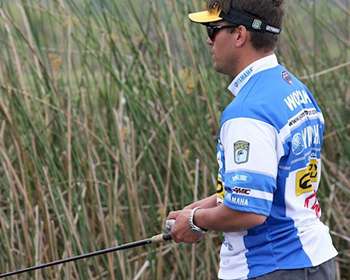
You would never go off-roading in a Jeep with 12-inch tires. It just wouldn't get the job done. Try mowing a 10-acre field with a push mower, and you'll soon realize that mismatches put you at quite a disadvantage. Likewise, when it comes to selecting the right hook, bigger is sometimes better.
Bassmaster Elite Series pro Dave Wolak believes there are times when a small bait paired with a big hook is just what the doctor ordered. "The real key to flipping a small bait for big fish is the hook," he reveals. "You want to use the absolute biggest hook you can get away with."
Wolak submits that fishing in heavy grass is the perfect opportunity for the small bait/big hook combination to shine. "I'll usually use a small creature bait paired with a big hook and a 1 1/2-ounce weight," he says. "The hook needs to be heavy and strong because chances are that you'll be hauling up a 3- or 4-pound bass through 10 pounds of grass."
The North Carolina pro also favors a jumbo hook when bed fishing. "When I have a fish on the bed, particularly in clearer water, I rarely use a giant soft plastic," he says. "Instead, I like to throw a small crawfish or stickbait rigged on the biggest hook I can fit in the bait. Also, in these situations I'll use braided line and a big hook with a little bait because I want the confidence of knowing that when the fish bites I'll be able to get it into the boat."
Hook size, in relation to the size of the bait, isn't only applicable to soft plastics. In fact, Wolak points out that he routinely upgrades the front treble hook on his crankbaits and jerkbaits. "When you do that, the bait tends to run nose down a little more," he says. "Think about it, that rear hook is the one that tends to get caught on everything. If you're fishing around grass or heavy cover, you're going to want your bait to run nose down so you can avoid snags."
But how big is too big? Wolak explains that on-the-water testing is required to achieve the right balance. "A lot of times you're going to know that you've gone too big just by how the bait runs," he says. "It involves a little testing to know for sure."
In Northern waters, where jumbo smallmouth bass are commonplace, Wolak explains that upgrading to a bigger hook is a necessity. "Northern smallmouth tend to prefer smaller jerkbaits, so upsizing hooks is just a requirement," he says.
"If you're up at Lake Erie and you take a jerkbait out of the package and start throwing it, chances are you'll lose a lot of bass because the hooks won't be strong enough to handle those giants."




